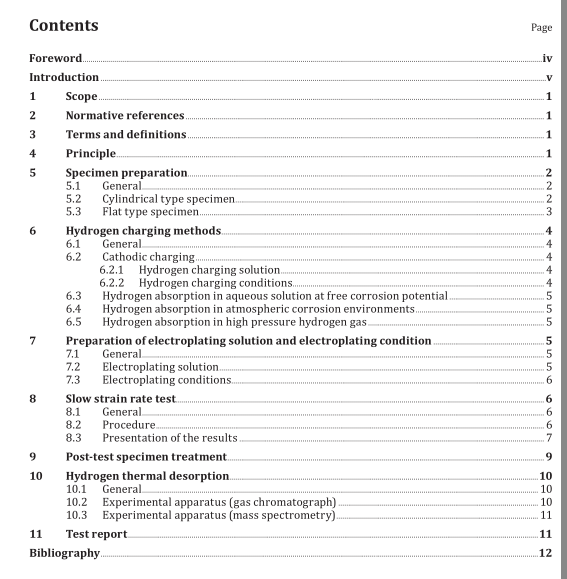ISO 16573-2 pdf download

ISO 16573-2 pdf download Steel — Measurement method for the evaluation of hydrogen embrittlement resistance of high-strength steels — Part 2: Slow strain rate test
7.3 Electroplating conditions An electrochemical reaction is used for Cd plating. Immerse the metal platinum (Pt) anode into the prepared Cd solution, and immerse the specimen in order for it to work as a cathode. After hydrogen pre-charging, clean the specimens by mechanical grinding (polishing) or with 0,1 N HCl and 0,1 N NaOH by ultrasonic cleaner for 30 s, respectively.
Then, immerse the specimens in Cd plating solution and apply a constant current of 0,5 A for 300 s. Other conditions of current and time may also be used for Cd plating. Using the potential difference, Cd is adhered to the surface of the specimen. The thickness of Cd plating should be at least 15 μm or higher to prevent hydrogen release. Extreme care is needed to handle the solutions containing Cd during the entire Cd plating procedures.
8 Slow strain rate test
8.1 General This test measures the loss of material strength and ductility in the hydrogen charged specimen as compared to the uncharged one and determines which composition or microstructure reveals higher resistance to hydrogen embrittlement. Slow strain rate test shall be performed by use of general tensile testing machines in accordance with the requirements of ISO 7500-1, ISO 6892-1 and ISO 6892-2.
8.2 Procedure
a) Use adequate jig and tensile test system to apply uniaxial loading to the specimens. Chamber with environmental controller shall be used in SSRT if the behaviour of hydrogen pre-charged specimen at various environment should be considered. Generally, the temperature of the chamber should be in the range (-40 °C to 85 °C) in accordance with the criterion accepted for all hydrogen fuel stations. NOTE Here, “environment” represents temperature, humidity, etc.
b) Measure fracture strength of specimens containing various diffusible hydrogen contents. In the case of hydrogen continuous charging, various current densities should be applied to measure the degradation of fracture strength.
c) Use a constant strain rate to pull the test specimen. For both smooth and notched tension specimens, use a strain rate of 10 -5 /s (with the tolerance of ±30 %) based on 25 mm of the gage length of the specimen. An extensometer shall be used to measure the strain rate. For full characterization of the hydrogen embrittlement behaviour or the material, it can be necessary to conduct a wide variety of tests at strain rates either higher or lower than the values stated herein.
d) From the relation between test force (or stress) and extension (or strain) of smooth specimen, measure tensile properties such as yield strength (proof strength), tensile strength, fracture strength (calculated from load at fracture/fractured area), elongation to fracture and reduction area. In the case of notched specimen, measure notch tensile strength and notch fracture strength (calculated from the load at fracture/fractured area).
e) To assure the reliability, at least 3 specimens shall be tested with the same cross head speed.
f) After the slow strain rate test, measure diffusible hydrogen contents of the specimen immediately. If it is impossible to measure diffusible hydrogen content just after the test, specimens should be preserved below –50 °C, preferably in liquid nitrogen, to prevent hydrogen release from the fractured surface. Freezer or dry ice box where the temperature is controlled under -50 °C shall be used to preserve the specimens. In such cases, maximum preservation period should be one week. Alternatively, the thermal desorption analysis of pre-charged but not stressed samples allows the quantification of the initial diffusible hydrogen content.
8.3 Presentation of the results
a) Several examples of the results obtained by the slow strain rate test are shown in Figures 4, 5 and 6. Results shall be displayed in the form of curves in which the horizontal axis represents the diffusible hydrogen content and the vertical axis represents the susceptibility to hydrogen embrittlement through the property chosen for representing it. Figures shall be drawn in log-log coordinates. Results shall also be expressed as coefficients a and b where log(Y) = a log10(X) + b. Curves generally contain at least 5 measured values. Those measured data shall be regularly distributed. The ratio of diffusible hydrogen contents of maximum value and minimum value should be at least 10.
b) In Figure 4, the horizontal axis indicates the diffusible hydrogen content of the specimens and the vertical axis represents either fracture strength in the smooth specimen or notched fracture strength in the notched specimen. In Figure 5, the horizontal axis should be the diffusible hydrogen content, and the vertical axis represents notch tensile strength. In the case of smooth specimen, the vertical axis may represent ductility such as reduction of area or elongation to fracture as shown in Figure 6.
c) In Figures 4 to 6, the vertical axis shall be replaced by the parameter such as fracture strength/ tensile strength, and/or the horizontal axis shall be replaced by current density (mA/mm 2 ). d) It shall be concluded that the susceptibility of hydrogen embrittlement is severe if the vertical axis parameter of a material is lower than that of the competitive material at the specific diffusible hydrogen content, or at the specific current density.









